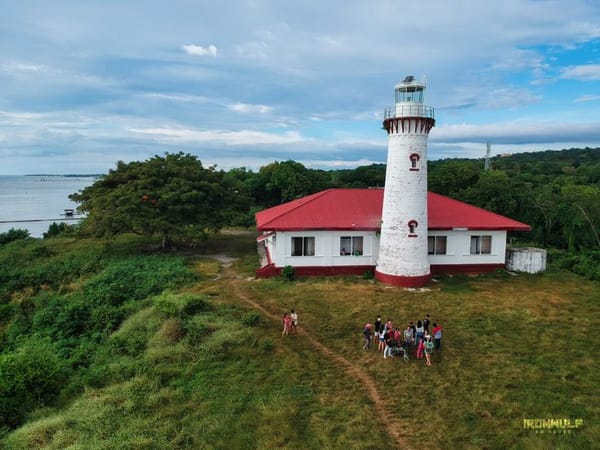Cape Santiago Lighthouse has stood proudly over Balayan Bay for more than a hundred years, silently watching over Calatagan's shores. This iconic lighthouse is not just a tool for navigation; it represents the rich maritime history and architectural excellence of the Philippines.
Why Historical Landmarks Matter
Historical landmarks like Cape Santiago Lighthouse connect us to our past. They share stories of cultural growth, technological progress, and human resilience. These structures not only preserve our heritage but also attract visitors seeking genuine connections with local history.
The Significance of Cape Santiago Lighthouse
The white walls and Spanish colonial design of the lighthouse have become symbols of Calatagan. Its existence has influenced the town's evolution from a peaceful fishing village to a bustling tourist hotspot. This change is part of the larger narrative of tourism in the area, where historical sites such as the lighthouse play a crucial role in drawing visitors.
What You'll Discover Here
Are you ready to uncover the wonders of Cape Santiago Lighthouse? Here's what we'll explore:
- The intriguing tale behind its creation
- Its breathtaking architectural features
- The significance of the lighthouse during various historical eras
- Recent efforts to preserve it
- Its influence on local culture
- Tips for planning your visit
Whether you're passionate about history, fascinated by architecture, or simply seeking out unique places to explore in Calatagan, Cape Santiago Lighthouse promises an unforgettable experience that showcases the Philippines' vibrant maritime heritage. You may also want to learn more about Calatagan communities, their lifestyle, and how they have changed over time.
1. A Glimpse into History: The Story Behind Cape Santiago Lighthouse
The Spanish colonial era marked a significant chapter in Philippine maritime history with the establishment of lighthouses across the archipelago. In the 1800s, Spain recognized the critical need for navigational aids to guide ships through the treacherous waters surrounding the Philippine islands.
The story of Cape Santiago Lighthouse began in 1887 when Spanish engineer Magin Pers y Pers submitted a comprehensive proposal for a network of lighthouses. His vision included strategic placement of these beacons along crucial maritime routes, with Cape Santiago identified as a vital point for safe passage through Balayan Bay.
Construction timeline of Cape Santiago Lighthouse:
- 1890: Initial groundwork and foundation laying
- 1891-1893: Main tower construction phase
- 1894: Installation of lighting equipment
- 1895: Official inauguration and first light
The lighthouse project fell under the supervision of Guillermo Brockman, the Director of Public Works. His expertise ensured the structure's durability against harsh coastal conditions while maintaining architectural authenticity.
The Spanish government invested significant resources in this project, recognizing its importance for:
- Safe maritime commerce routes
- Protection of Spanish naval vessels
- Support for local fishing communities
- Enhanced military surveillance capabilities
The lighthouse stood as a testament to Spanish engineering prowess, incorporating advanced lighting technology of its time. Its octagonal tower design allowed for optimal light projection across Balayan Bay, while its strategic location provided clear visibility for ships navigating between Manila and the Visayas region.
This historical site is not just a beacon for ships but also a symbol of Calatagan's rich history and culture. As you explore Calatagan, don't miss out on Bagong Silang, one of its vibrant communities known for its unique lifestyle and local stories. You can also explore Calatagan's beautiful beaches and nature escapes or indulge in the top restaurants and local delicacies that the area has to offer. For those looking to promote their business in this thriving community, Calatagan.xyz offers an excellent platform for reaching local readers and gaining exposure. Lastly, immerse yourself in local culture by discovering the hidden gems within Calatagan’s barangays through this comprehensive travel guide.
2. Architectural Marvel: Exploring the Design of Cape Santiago Lighthouse
Cape Santiago Lighthouse is a remarkable example of Spanish colonial engineering, standing tall at 15.5 meters overlooking Balayan Bay. Its octagonal tower showcases the skilled craftsmanship of its era, constructed with a combination of brick and lime cement that has endured the test of time against coastal elements.
Distinct Features of the Lighthouse's Design
The design of the lighthouse incorporates several architectural elements that are characteristic of Spanish colonial style:
- A solid stone foundation that provides stability to the structure
- Thick walls measuring 1.5 meters at the base for durability
- A spiral staircase with 65 steps leading up to the lantern room
- Decorative cornices and moldings typical of Spanish colonial architecture
- Original brass and copper fittings in the lighting mechanism
Influence of Spanish Colonialism on Architectural Style
The aesthetic details of the lighthouse clearly reflect the architectural influence of Spanish colonialism. Similar to other lighthouses built during that period - such as Cape Bojeador in Ilocos Norte and Capones Island Lighthouse in Zambales - Cape Santiago exhibits key features commonly found in 19th-century Spanish maritime architecture:
- Symmetrical design elements
- Arched windows and doorways
- Intricate masonry work showcasing skillful craftsmanship
- Neoclassical decorative touches adding elegance to the structure
Practical Considerations in Colonial Lighthouse Design
Attached to the main tower is the lighthouse keeper's dwelling, which embodies practical aspects of colonial lighthouse design. This two-story quarters was built using the same sturdy materials as the tower, providing accommodation for the keeper and storage space for maintenance supplies.
Innovative Lighting System Guiding Ships
Atop the structure sits the lantern room housing an original French-made lighting apparatus, safeguarded by a copper dome and glass panels. This advanced system once directed ships with its powerful beam visible up to 20 nautical miles away, ensuring safe passage through treacherous waters.
Cape Santiago's Significance Beyond Architecture
In addition to its architectural importance, Cape Santiago Lighthouse holds significance as a prominent landmark in the region encompassing areas like Balitoc, renowned for its distinctive lifestyle and hidden treasures.
3. Guiding Ships Through Time: The Operational History of Cape Santiago Lighthouse
Cape Santiago Lighthouse has been an essential navigational guide for many ships navigating through the difficult waters of Balayan Bay. Its powerful light can be seen from 25 nautical miles away, helping vessels find their way safely even in darkness or bad weather.
Significant Historical Events
The lighthouse has been a witness to important historical events over the years:
- During the Philippine-American War (1899-1902), both American troops and Filipino revolutionaries used the lighthouse as a lookout point. The Americans kept an eye on naval activities from its high vantage point, while the Filipinos tried to gain control over this crucial maritime asset.
- World War II brought another significant chapter to the lighthouse's story. Japanese forces took over the structure and turned it into a military base. The occupation left visible scars on the building, with bullet marks still visible on its walls today - silent testimonies to the conflicts it endured.
Technological Upgrades
In 1978, a major change happened when the lighthouse became automated. The Philippine Coast Guard replaced the original lighting system with:
- Modern solar-powered LED lights
- Automated timing systems
- Updated weather monitoring equipment
- Digital navigation aids
This technological improvement reduced the need for permanent lighthouse keepers while ensuring that the structure continued to serve its purpose. The automated system now operates around the clock, flashing its distinctive pattern every 10 seconds:
Flash: 1 second
Eclipse: 9 seconds
Preserving History
Even with these modern upgrades, the lighthouse still maintains its historical charm. The quarters where keepers used to live are still standing and have now been transformed into a museum space. Here, visitors can explore and discover the rich maritime heritage associated with the lighthouse and learn about the devoted individuals who once took care of this symbol of safety at sea.
4. Preserving Heritage: Restoration Efforts at Cape Santiago Lighthouse
Cape Santiago Lighthouse has undergone several significant restoration projects to maintain its structural integrity while preserving its historical essence. The Philippine Coast Guard, in partnership with local authorities, initiated a major renovation in 2005 that focused on:
- Reinforcing the lighthouse's foundation
- Repairing weather-damaged sections of the tower
- Restoring the original Spanish-era brickwork
- Installing modern safety features
A second restoration phase in 2012 brought additional improvements:
- Updated lighting system installation
- Enhanced weather protection measures
- Restoration of the keeper's quarters
- Landscape rehabilitation around the premises
The lighthouse's cultural and historical significance received official recognition when the National Historical Commission of the Philippines declared it a National Historical Landmark in March 2018. This designation brought:
- Protected status under Philippine heritage laws
- Increased funding for preservation efforts
- Regular maintenance schedules
- Professional conservation guidance
Local community groups actively participate in preservation efforts through:
- Monthly cleanup drives
- Educational tours for schools
- Documentation of the lighthouse's history
- Coordination with heritage conservation experts
These efforts not only help preserve the lighthouse but also enrich the local cultural experience, allowing residents and visitors alike to connect with the region's rich history. The restoration work strikes a careful balance between maintaining the lighthouse's authenticity and ensuring its continued functionality as a vital maritime beacon. Each preservation project adheres to strict heritage conservation guidelines while incorporating necessary modern safety standards.
5. Beyond Tourism: The Cultural Significance of Cape Santiago Lighthouse
Cape Santiago Lighthouse is more than just a tourist attraction; it holds deep cultural significance for the residents of Calatagan. Here's why:
A Symbol of Identity
For the people of Calatagan, Cape Santiago Lighthouse represents their local identity. It has become a symbol that connects them to their history and community.
- Collective Memory: The lighthouse has shaped the memories of generations, with stories being passed down about its importance in their lives.
- Guiding Light for Fishermen: Local fishermen still rely on the lighthouse as a familiar landmark that guides them safely back home.
- Showcasing Maritime Heritage: Residents take pride in displaying the lighthouse as a testament to their rich maritime heritage.
Inspiration for Artists
The beauty and grandeur of Cape Santiago Lighthouse have inspired many local artists. They express their creativity through various art forms, capturing the essence of the lighthouse.
- Paintings: Artists create stunning artworks depicting the lighthouse and its surroundings.
- Photographs: Photographers capture breathtaking images that showcase the lighthouse's beauty from different angles.
- Crafts: Artisans craft unique souvenirs and products inspired by the lighthouse, which are sold in nearby markets.
These artistic interpretations not only help preserve the cultural legacy of the lighthouse but also provide economic opportunities for creative members of the community.
Community-Led Tourism Initiatives
Local organizations in Calatagan have recognized the potential of Cape Santiago Lighthouse as a catalyst for sustainable tourism development. They have implemented programs that promote both the area's history and its vibrant lifestyle.
Some notable initiatives include:
- Heritage Walking Tours: Trained local guides lead tours where they share authentic stories and historical knowledge about landmarks like Cape Santiago Lighthouse.
- Cultural Festivals: Annual celebrations are held at the lighthouse grounds featuring traditional performances and food, showcasing the best local cuisine in Calatagan.
- Youth Education Programs: Schools organize visits to teach students about maritime history and environmental conservation.
These efforts not only attract visitors but also benefit the local community by creating jobs and supporting small businesses.
Environmental Conservation Measures
As tourism grows around Cape Santiago Lighthouse, it is essential to prioritize environmental conservation. The community has taken proactive steps to protect Balayan Bay's ecosystem:
- Designated Viewing Areas: Specific spots have been established for tourists to enjoy views without causing erosion or damage to natural habitats.
- Waste Management Systems: Proper waste disposal methods are implemented to ensure cleanliness and sustainability in the area.
- Limited Visitor Capacity: During peak seasons, measures are put in place to control the number of visitors and prevent overcrowding.
- Support for Local Fishing Practices: The community encourages sustainable fishing practices among local fishermen to maintain biodiversity in Balayan Bay.
These initiatives reflect Calatagan's commitment to balancing tourism growth with environmental stewardship.
Preserving Cultural Heritage
In addition to promoting tourism, efforts are being made to preserve Calatagan's cultural heritage:
- Documentation Projects: Local historians and researchers document oral histories, traditions, and customs associated with Cape Santiago Lighthouse.
- Collaboration with Indigenous Communities: Partnerships are formed with indigenous groups who have ancestral ties to the area, ensuring their voices are included in decision-making processes.
- Promotion of Traditional Arts: Workshops and exhibitions celebrate traditional crafts such as boat-making or weaving that are integral parts of Calatagan's culture.
By actively involving various stakeholders, these initiatives aim at safeguarding both tangible (physical structures) and intangible (traditions) aspects of heritage connected to Cape Santiago Lighthouse.
Through these combined efforts – community-led tourism initiatives, environmental conservation measures, preservation activities – Cape Santiago Lighthouse continues evolving beyond its original purpose as merely guiding ships; it becomes a platform fostering cultural exchange between residents visitors alike while promoting sustainable development within Calatagan.
Visiting Cape Santiago Lighthouse: A Practical Guide for Travelers
Ready to explore this historic beacon? Here's what you need to know:
Location & Getting There
- Address: Brgy. Sta. Ana, Calatagan, Batangas
- GPS Coordinates: 13°49'26"N 120°37'05"E
- Distance from Manila: ~120 kilometers
Transportation Options
- From Batangas City: Take a bus to Calatagan (2 hours)
- From Tagaytay: Drive through Nasugbu (1.5 hours)
- Private Vehicle: Best option for flexibility
Best Time to Visit
- Opening Hours: 8:00 AM - 5:00 PM
- Peak Season: December to May
- Photography: Early morning for best lighting
Perfect Day Trip Itinerary
- 8:00 AM - Start at Cape Santiago Lighthouse
- 10:00 AM - Beach hopping at Calatagan's white sand shores
- Manuel Uy Beach
- Burot Beach
- 2:00 PM - Water activities
- Snorkeling
- Kayaking
- Stand-up paddleboarding
Weekend Adventure Ideas
- Day 1: Lighthouse visit + beach activities
- Day 2: Choose from:
- Island hopping to Starfish Island
- Mangrove forest exploration
- Sunset sailing at Balayan Bay
Local Tips
- Book accommodations in advance during peak season
- Bring water and snacks
- Wear comfortable walking shoes
- Pack sun protection
- Bring a camera for stunning lighthouse shots
For more local insights, including hidden gems and trusted businesses in the area, check out our comprehensive Calatagan travel guide. Whether you're interested in exploring the lifestyle of Balibago or seeking out specific services through our Calatagan directory, we've got you covered!
Conclusion
Cape Santiago Lighthouse is a symbol of Calatagan's rich maritime history. This 15.5-meter tall lighthouse has guided many ships through Balayan Bay, evolving from a Spanish colonial outpost to a beloved national treasure.
What makes this lighthouse special is its dual significance:
- A living piece of Philippine history, witnessing centuries of change from Spanish rule through World War II
- An architectural marvel that continues to serve its original purpose while attracting visitors from around the world
The lighthouse's recent recognition as a National Historical Landmark in 2018 solidifies its status as one of the most important cultural sites in the Philippines. Its sturdy brick walls and worn-out steps hold stories of lighthouse keepers, passing ships, and a community that thrived around its constant light.
Your visit to Cape Santiago Lighthouse isn't just another tourist destination - it's an opportunity to step back in time. Each climb up its spiral staircase, each moment spent looking out over Balayan Bay from its viewing deck contributes to the ongoing narrative of this extraordinary structure.
We invite you to experience the wonder of Cape Santiago Lighthouse for yourself. Come find out why this unwavering guardian has captured hearts for generations, and add your own story to its lasting legacy in Calatagan.
While you're in Calatagan, consider exploring some of the private villas available for rent, which offer a unique way to experience the local culture. You might also want to delve into the about section of our website for more insights into the area's history and attractions.
If you're traveling with family, there are plenty of family-friendly activities that you can enjoy together. And for those who appreciate good food, don't miss out on visiting Hilltop Ramen Hauz, known for its authentic Japanese ramen and rice meals at affordable prices.
Lastly, remember that Calatagan is not just about individual experiences but also about community. The warmth and hospitality of the locals will surely make your visit even more memorable.
FAQs (Frequently Asked Questions)
What is the significance of Cape Santiago Lighthouse in the Philippines?
Cape Santiago Lighthouse is a prominent historical landmark that plays a crucial role in tourism and cultural preservation in the Philippines. It symbolizes maritime navigation history and reflects the rich cultural heritage of the region.
Who were the key figures involved in the establishment of Cape Santiago Lighthouse?
The establishment of Cape Santiago Lighthouse during the Spanish colonial era was notably influenced by key figures such as Magin Pers y Pers, who proposed its construction, and Guillermo Brockman, who oversaw its building process.
What architectural features define Cape Santiago Lighthouse?
Cape Santiago Lighthouse stands 15.5 meters tall and is constructed using brick and lime cement. Its architectural style showcases Spanish colonial influences, which can be compared to other lighthouses throughout the Philippines.
How has Cape Santiago Lighthouse served as a navigational aid over time?
Since its inception, Cape Santiago Lighthouse has been a vital navigational aid for vessels traversing Balayan Bay. It underwent automation in 1978 to enhance its functionality, allowing it to continue guiding ships effectively into modern times.
What restoration efforts have been made to preserve Cape Santiago Lighthouse?
Various restoration projects have been undertaken to maintain the structural integrity and cultural value of Cape Santiago Lighthouse. In March 2018, it was recognized as a National Historical Landmark, emphasizing its importance within Philippine heritage sites.
Calatagan is more than a destination—it’s a lifestyle. 🌴 With its warm community, scenic views, and laid-back coastal charm, it’s the perfect place to live and thrive.







